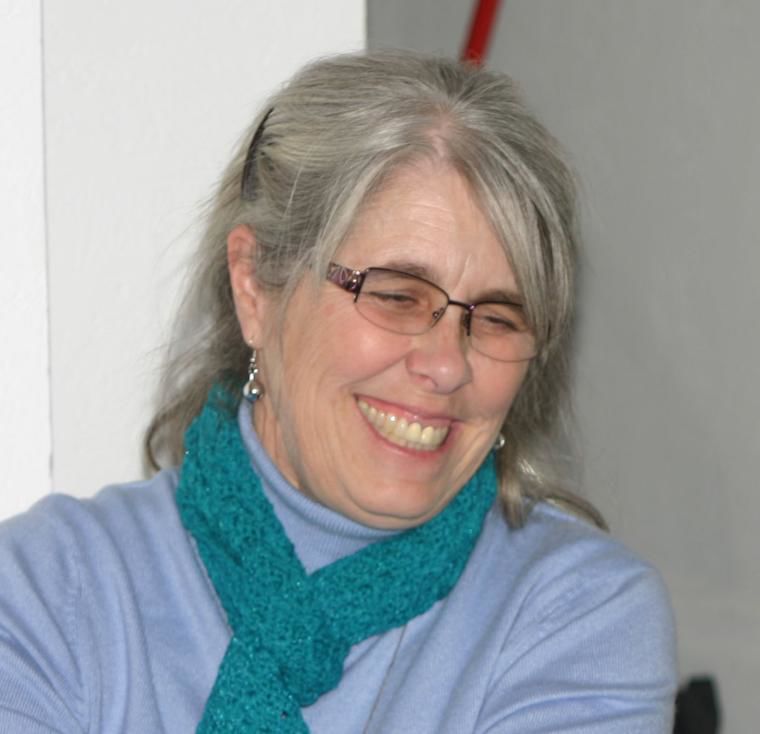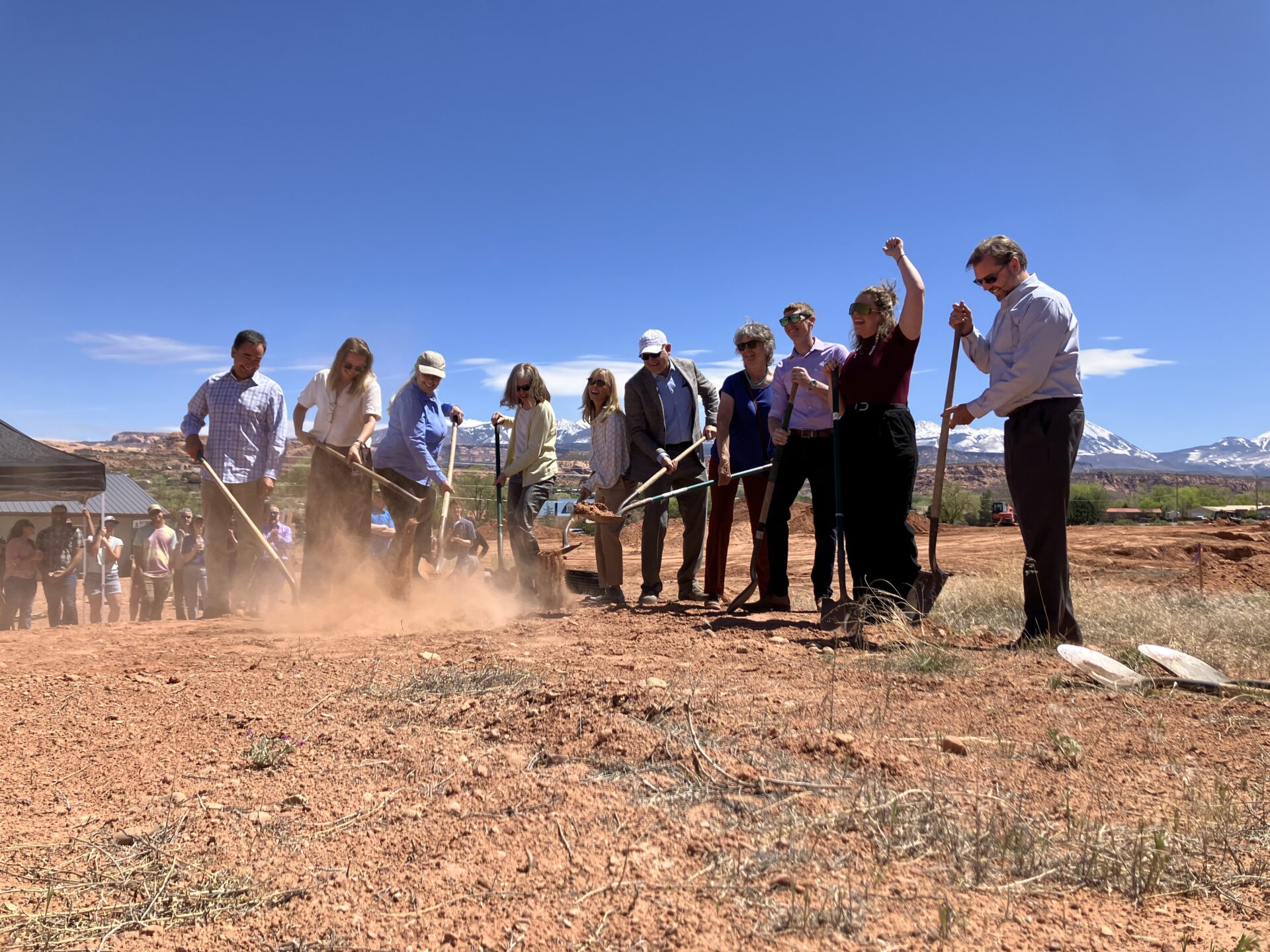Jowaner Harmon was at the Grand County Library on April 30 researching affordable housing options already in existence in the community that may be able to assist her right now. As Harmon looked at websites on a computer, the Moab Area Community Land Trust was steps away, meeting in the library’s Board Room to discuss a new 32-acre development for worker-based affordable housing.
Harmon, 43, said she works at a fast food restaurant in Moab, but explained that her wages and the cost of housing are a challenge.
“Right now I’m out here [living] on the streets,” Harmon said. “I’m trying to find me a bed just to lay my head down.”
She said she has been in Moab for about eight months and has been working full time, but says she is unable to secure housing that is affordable.
That issue was at the forefront of discussion among the board members of the Moab Area Community Land Trust.
Board members revealed that 32 acres of privately owned land on South Spanish Valley Drive are officially being transferred in mid-May to the Moab Area Community Land Trust. The agreement between the land donor and the land trust is placing restrictions on the property’s deed, 2022 S. Spanish Valley Drive, to allow the land only to be developed into affordable housing for people employed locally, board members said.
“We will be using those restrictions in perpetuity,” Audrey Graham, chair of the board of directors of the Moab Area Community Land Trust, said.
LAND DONATED BY LOCAL PHILANTHROPIST
The board did not release the name of the person donating the 32 acres on South Spanish Valley Drive. In previous news reporting, the owner of the land is listed with the Grand County Recorder’s Office as the Palladium Foundation of Salt Lake City. Moab area resident Jennifer Speers, well known for her philanthropic involvement in the community, is identified in other online documents as the foundation’s president.
The board said the original plan to transfer the land to the Moab Area Community Land Trust was stalled — 11 months have now passed since the land was purchased by the Palladium Foundation — because insurance first had to be secured for the land trust’s board, Graham said.
The Moab Area Community Land Trust started in 2009 and earned its 501(c)(3) nonprofit status in 2012. The land trust does collaborate with local government officials, but operates independently of any county or city agencies. Funding for the land trust comes from donations from individuals in the community.
Ben Riley, the executive director of the Housing Authority of Southeastern Utah, said they plan to work with the land trust as it moves forward
“HASU has been involved in providing technical assistance to the land trust as they have put together their organizing documents. We realize that the land trust will be a significant asset and are trying to provide whatever assistance we can,” Riley said in a May 1 email.
Board members discussed the land transfer process for the majority of the meeting. The board drafted and is reviewing a memorandum of understanding (MOU) that was requested by the land owner, said Graham.
LAND TRUST FORMS A CO-OWNERSHIP MODEL
Once developed, employers will be able to put in requests for housing for their employees. Board member Rani Derasary questioned whether there would be an imbalance in the number of different businesses in the community who will be requesting employee housing, and wondered how the land trust would prevent one employer from “grabbing up” and requesting a majority of the housing.
“Do you know, in talking to other land trusts, how they balance the interest on employers
interested … in employee housing?” Derasary said.
Graham said the board is still talking about the “ins-and-outs” of balancing employers who request housing for employees, and is talking to other land trusts in the country to learn more.
The board’s vice chair, Kaitlin Myers, said that with the size of the housing plan, she does not think there will be a problem in balancing employer requests.
The model the board is striving to create may set aside units for essential workforce, community partners and local businesses who partner to invest in the development of the land, board members said.
Townhouses, apartments, some single family homes and tiny homes were mentioned by the board as being on the table for the development plans; all of those may be sold or made available to rent.
The land trust will then act as a mediator, or buffer, between the employees and the employers who are requesting the housing, board members said.
“It’s a co-ownership model and the land trust works with the owner on financial education and better stewardship of homes. That’s something I am really passionate about in the context of land trusts,” Myers said.
Graham discussed the issue around various employees, from park rangers to river guides, who have seasonal employment. She said seasonal workers may qualify for affordable housing based on their employment and offered reassurance in saying that seasonal employees would not lose their employee housing once their seasonal employment ended.
Graham said there are over 200 land trusts in the United States; the Moab land trust is one of just two land trusts in the state of Utah.
The board has been in talks with Park City-based Mountain Lands Community Housing Trust, to learn more about the models available for the land trust as it moves forward with affordable housing plans.
“[Lands trusts are] a very successful way of getting affordable housing into communities,” Graham said.
Back on the street in front of the Grand County Library, Harmon stood on the sidewalk and explained what she sees on the streets and what affordable housing means to people employed in Moab.
“What it would mean to me is that I’m culturally taken care of, I have a roof over my head, I have a place to cook,” said Harmon, who came to Moab from Salt Lake City.
“I came out here to make money, but let me tell you, it’s high maintenance out here,” Harmon said, referring to housing costs. “It’s kind of ridiculous.”
Harmon paused and then said, “You have all of these homeless people in the area, some of us are working — we’re not bad people.”
LAND TRUST SEEKS INVESTORS
The board is now looking for investors and partners, especially local businesses who are interested in creating employee-based housing in the area.
“We hope to work with developers to phase the development and we will work with all developers who are interested,” Graham said.
The board made a motion approving Graham to sign all associated documents between the land donor to the Moab Area Community Land Trust. The board will look at its budget and make final decisions on the property’s taxes and insurance closer to the closing date in mid-May, board members said. The exact date for the land transfer was not released.
Additional meeting agenda included the board’s approving prior meeting minutes and reviewing financial reports. The land trust has about $2,041 in the bank. Graham said she raised $560, exceeding a $200 goal, in a Facebook fundraiser she started on April 29 for her birthday and is donating that money to the land trust. A volunteer CPA is keeping up with the agency’s QuickBooks and finances.
In closing the meeting, Graham said, “The main thing to me that the public ought to know, is that if they want to donate land, they can put some stipulations on that land, and we will honor that.”
For Harmon, the main thing for her is having a place to cook and take a shower.
“If you were out there homeless and someone told you you have a place to go, that’s closure for you. You have a second chance to get your life together,” she said.
Land trust says transaction will be official in mid-May
“It’s a co-ownership model and the land trust works with the owner on financial education and better stewardship of homes. That’s something I am really passionate about in the context of land trusts.” – Kaitlin Myers




